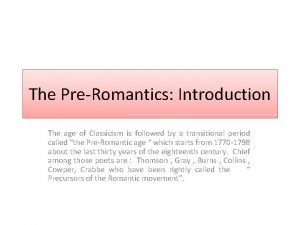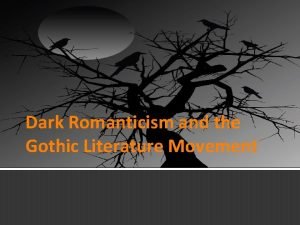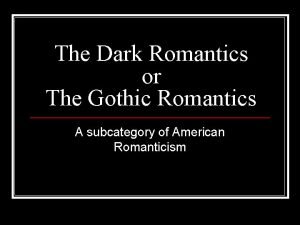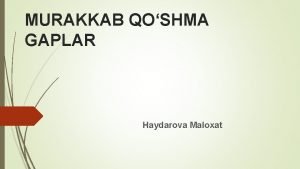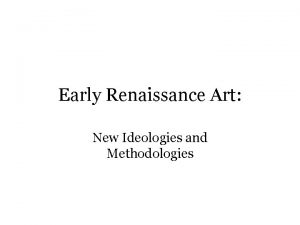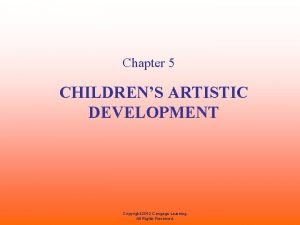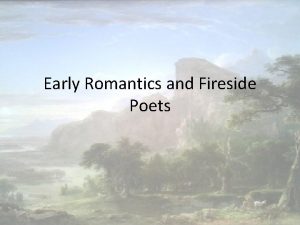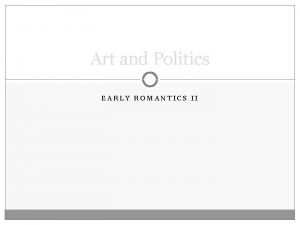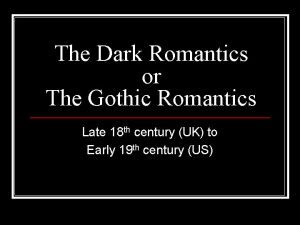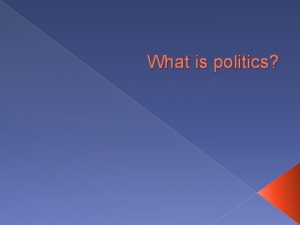Art and Politics EARLY ROMANTICS II The gap









- Slides: 9

Art and Politics EARLY ROMANTICS II

�The gap between nature and reason �The aesthetic as the principle of uniting the opposites, and therefore a principle of possible political change �Influence of Schiller – beauty as crucial to the cultivation of the moral life �Influence of Kant – the aesthetic experience as understanding of the world �Sense of individuality

Early Romanticism �Late 18 th century, Jena �Journal Athenäum �August and Friedrich Schlegel (literary critics), Friedrich Schleiermacher (theologian), Ludwig Tieck (writer and critic), Friedrich Schelling (philosopher), Caroline Michaelis Böhmer Schlegel Schelling (literary critic), Dorothea Mendelssohn Veit Schlegel (novelist and translator), Friedrich von Hardenberg/Novalis (poet) �Friedrich Hölderlin (poet)


The aesthetic revolution �The aesthetic unity and the aesthetic sovereignty �Poetry �The aesthetic revolution as an open process of enlargement of human possibilities (Fr. Schlegel) �The absolute

A new mythology �Response to the differentiation of spheres in modernity �Mythology in the sense of the meaning and nature of reality �Art can point beyond itself towards an unpresentable absolute �Synthesis in a new kind of culture

The Oldest System Programme of German Idealism (1797) �Radical notion of freedom („The first idea is naturally the notion of myself as an absolutely free being. “) �Critique of state as mechanical �Beauty as unity �Art as an utopian symbol of the realization of freedom

�„I am now convinced that the highest act of reason, which embraces all ideas, is an aesthetic act, and that truth and goodness are brothers only in beauty. “

„First of all I shall speak here of an Idea which, as far as I know, has never occurred to anyone – we must have a new mythology, but this mythology must be in the service of the Ideas, it must become a mythology of reason. Before we make the Ideas aesthetic i. e. mythological, they are of no interest to the people and on the other hand before mythology is reasonable the philosopher must be ashamed of it. Thus enlightened and unenlightened must finally shake hands, mythology must become philosophical and the people reasonable, and philosophy must become mythological in order to make the philosophers sensuous. Then eternal unity will reign among us. Never the despising gaze, never the blind trembling of the people before its wise men and priests. Only then can we expect the same development of all powers, of the individual as well as all individuals. No power will be suppressed any more, then general freedom and equality of spirits will reign! – A higher spirit sent from heaven must found this new religion among us, it will be the last, greatest work of mankind. “
 Pre romantic poet
Pre romantic poet Modern dark romanticism
Modern dark romanticism Dark romanticism and gothic literature
Dark romanticism and gothic literature Dark romanticism characteristics
Dark romanticism characteristics Early cpr and early defibrillation can: *
Early cpr and early defibrillation can: * Murakkab qo'shma gaplar misollar
Murakkab qo'shma gaplar misollar Compiler bridges the semantic gap between which domains?
Compiler bridges the semantic gap between which domains? Characteristics of early renaissance art
Characteristics of early renaissance art Early christian art
Early christian art Kellogg's stages of drawing
Kellogg's stages of drawing
